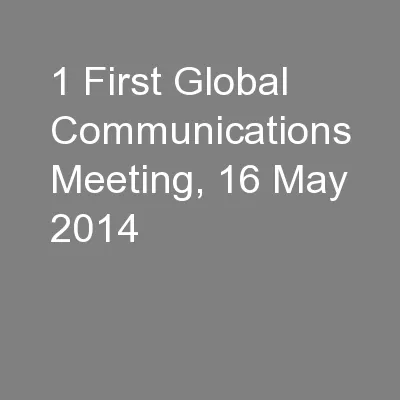

Media Relations and Monitoring in the Runup to 2015 Eric Karstens The satisfied audience 2 2 is silent Metrics everywhere Across the board we currently have an ID: 340180
Download Presentation The PPT/PDF document "1 First Global Communications Meeting, 1..." is the property of its rightful owner. Permission is granted to download and print the materials on this web site for personal, non-commercial use only, and to display it on your personal computer provided you do not modify the materials and that you retain all copyright notices contained in the materials. By downloading content from our website, you accept the terms of this agreement.
Slide1
1
First Global Communications Meeting, 16 May 2014Media Relations and Monitoring in the Run-up to 2015Eric KarstensSlide2
The satisfied audience...
2
2
…
is
silentSlide3
Metrics everywhere
Across the
board, we currently
have
an
obsession
with impact
metrics.Rationales:
Each dollar spent
on
media
is a dollar not spent on vaccines, clean water, sanitation, etc.Accountability and need to justify investmentsApparent blanket availablity of measurements for anything and everything
3Slide4
Media impact
metrics
Bill & Melinda Gates Foundation and Knight
Foundation
are
sponsoring the „Media Impact Project“
at USC Annenberg to the tune
of $3.25m for 2.5 years
Central
and
focused methodology development and critiqueCharts and manuals how to define, achieve, and measure media impact, in particular when it comes to social causes or development
4Slide5
Media impact
metrics5Slide6
Media impact
metrics6Slide7
Real-world metrics
ProPublica understanding of impact metrics
:Palpably changing
the
real
world
Mayors
ousted
Laws enacted
Corruption
revealed …7Slide8
Media and real-
world impact
Does
this
mean
reducing journalism
and media
to
activist tools?„Your parents donate money, you send a Tweet.“ Internet activist Sascha Lobo at Re:Publica 2014„The public
good
is
not
identical
with
the
aggregated
intentions
of
organised interest“„Quality does not emerge from the aggregation of diverging interests, but from keeping open divergence“ German Constitutional Court, 2014
8Slide9
A changing public
Is an
informed
public
is
by
definition also a
proactive public?
Could
it be that we are faced with a different generation of audience that‘s weary of organisations? Choice and fragmentation may
have
lowered
the
willingness
of
individuals
to
cope
with organised interest and activism
9Slide10
(Social) Media
engagement10
“The people who share content are a small fraction of the people who visit that content. Among articles we tracked with social activity, there were only one tweet and eight Facebook likes for every 100 visitors
.
There is no relationship whatsoever between the amount a piece of content is shared and the amount of attention an average reader will give that content.”
Tony Haile, CEO,
ChartbeatSlide11
Engagement metrics
Online
engagement
metrics
are
largely unsuitable,
becauseyou preach
to the already converted
you
measure people who are activists/„meddlers“ to begin withSocial media posts often make a public statement about interestsor current
preoccupations
,
rather
than
being
a genuine
recommendation
„Dark
social
“
makes
up
for 50-80% of traffic on popular media websitesBut:People who spend more
time
reading
are
more
likely
to return (TTR)
11Slide12
The inverted pyramid of media impact
When
it comes to
impact
,
the
best measurement
is the before
-and-after differential in knowledge, awareness,
understanding
,
and – perhaps – opinionHow to get there?Change, or at least further develop, people‘s mindsTo this end, produce coverage
that
attracts
and
keeps
earnest
attention
To
this
end,
support quality journalism with the appropriate narrative and styleTo this
end,
engage
journalists
(
and
their
editors) firstTo this end, create interesting,
compelling, engaging
situations
for journalists
12Slide13
COP16 Climate Conference in Cancun, 2010
A „short-term, issue-specific transnational public
sphere“
„Networks
of
co-production
“
Shared workspace with „camp
feeling“: Journalists, PR pro-fessionals,
and
politicianspulled out of their usual routinewith bascially no choice butto interactJournalists see NGOs „like acompass“, putting delegationinformation into context, pro-viding story hooks and back-ground explanationsDirect
spinning
/
correction
opportunity
13Slide14
Quality-conscious
and sustainable media relations
Make sure
to
create
an
event/setting
that embraces divergence, even
if this appears
to
be contrary to your own communication interestFoster interdisciplinary cooperation and co-production in an unobtrusive fashionBuild lasting relationships with journalists even if at first they do not seem to produce coverage, let them
experience
a
process
Systematically put journalists and stakeholders from different countries in a room to break up “national containers”
Leverage
the
transnational
communications
role
of
news
agency journalistsEnable journalism in the first place: e.g., BMGF-supported grants programme „Innovation in Development Reporting“, stipends, exchanges, internships, „embedding“14Slide15
15
Thank you
!
ek@karstens.euSlide16
Selected references
Manuel Adolphsen, Julia Lück: Non-Routine Interactions Behind the Scenes of a Global Media Event
. In: Medien & Kommunikations-wissenschaft, Sonderband 2, Baden-Baden 2012, p. 141-158
Richard J.
Tofel
:
Non-profit journalism – Issues around impact: A white paper from
ProPublica, 2013
http://s3.amazonaws.com/propublica/assets/about/LFA_ProPublica-white-paper_2.1.pdfLFA Group: Learning for Action/Bill & Melinda Gates Foundation/John S. and James L. Knight Foundation:
Deepening Engagement for Lasting Impact: Measuring Media Performance and Results, 2013-14(forthcoming)
Tony
Haile
: What You Think You Know About the Web Is Wrong, 2014 http://time.com/12933/what-you-think-you-know-about-the-web-is-wrong/16